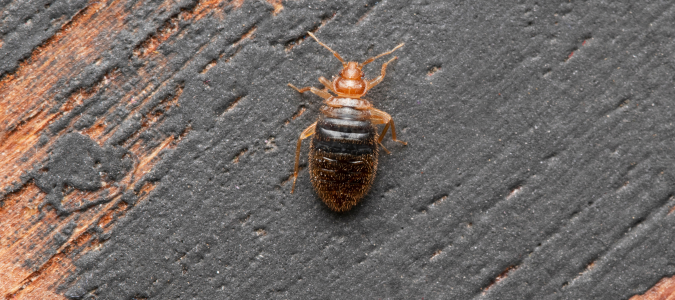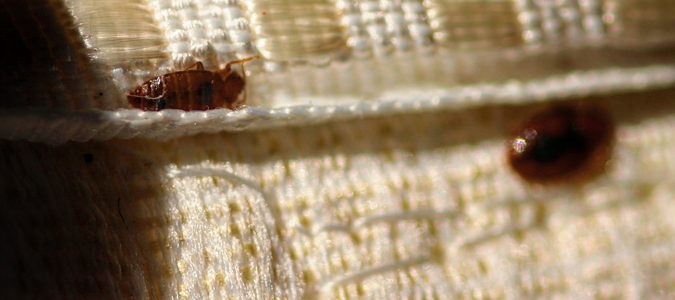Do you know the average life span and life cycle of bed bugs? These unwelcome pests can become extremely annoying for homeowners because they bite humans at night. In order to be proactive about bed bugs, it’s a good idea to learn about their life cycle, feeding habits and hiding places.
How Long Do Bed Bugs Live?
The life span of a bed bug depends on multiple factors, including temperature and available access to blood meals. When those factors work in their favor, bed bugs typically live for around one year. However, it’s common for bed bugs to only live for four to six months.
Bed bugs are extreme annoyances for homeowners, so it’s important to learn about the life cycle, feeding habits and common hiding places for bed bugs. The more you educate yourself about these nuisances, the quicker you can identify an infestation and contact a pest control specialist to control it.
The Bed Bug Life Cycle
Bed bugs go through these distinct phases during their life cycle: the egg phase, the nymph phase and the adult phase. Female bed bugs can lay up to 500 eggs in their lifetime, typically lying between one and five eggs a day.
Bed bug eggs are tiny, grain-like white eggs that are extremely difficult to spot if you aren’t trained. They’re laid in clusters and often hidden in tiny crevices where they won’t be disturbed.
The bed bug eggs hatch within two weeks, and the bed bug nymph emerges. Nymphs are considered young bed bugs. They molt five times before entering the adult stage. In order to molt and become adults, nymphs need to feed on blood meals. Bed bug nymphs look like bed bugs except for the fact that they are smaller and yellowish-white in color.
As bed bugs become adults, their color changes to reddish-brown. Once they reach adulthood, bed bugs begin to mate and start the life cycle over again. Adult bed bugs typically feast on a blood meal once a week.
The Feeding Habits of Bed Bugs
Blood meals are required for bed bugs to survive and reproduce. When they have easy access to a host that they can feed on, bed bugs typically feed weekly or every five to ten days.
However, if needed, bed bugs can go several weeks without a blood meal while they search for a new host. They can survive for up to 400 days without food in warm and humid climates. In cool climates, on the other hand, they will die within a few weeks without a blood meal.
In between blood meals, bed bugs digest and reproduce. As their name suggests, bed bugs typically live on or near mattresses and tend to feed at night while we’re sleeping. This is why it’s common to wake up with new bed bug bites when you’re dealing with an infestation in your home.
Common Bed Bug Hiding Places
Bed bugs are excellent hiders because they can fit into tiny crevices that are hard for humans to access. Common bed bug hiding places include:
- Mattresses and box springs
- Inside clothing, fabric and clutter
- Cracks and crevices in walls, furniture and flooring
- Headboards and bedframes
- Inside electrical outlets
Controlling a bed bug infestation is extremely difficult without expert help. A pest control specialist will know all of the unexpected bed bug hiding places and have the right tools to remove the unwanted pests. If you’re dealing with a bed bug infestation in your home, do not hesitate to call in a pest control expert as soon as possible. They can also help you learn how to check your bed for bed bugs.
Do Bed Bugs Crawl On Walls?
Bed bugs do not fly or jump, but they can crawl. They can speedily crawl over several types of surfaces, including walls, floors, furniture and fabric. Given their abilities, it’s normal for homeowners to wonder if bed bugs crawl on walls.
While bed bugs can crawl on walls, it’s not common to see them crawling on walls to tall heights. Since bed bugs typically feed on hosts who are in their beds at night, these pests prefer to stay low to the ground. Their primary activity is going between their hiding spot and their host for a blood meal.
When bed bugs are not feeding, they stay in their hiding spots so that they are out of sight and free to digest and reproduce undisturbed.
It is common for bed bugs to hide in crevices along walls, flooring and floorboards. That means that you could spot a bed bug crawling along a wall to get back to its hiding place. However, seeing them crawling very high up on walls is still uncommon.
Rather than climbing up walls, it’s more common to see bed bugs around your furniture, bed or in piles of clothing. Additionally, they may also hide in the folds of a curtain. They look for hiding spots with tiny cracks or textures so that they can go undetected.
Since they are quick crawlers and mostly move around at night, it’s extremely hard to catch a bed bug. The best way to get rid of a bed bug infestation is to call in professional help. A pest control specialist can find the bed bugs, control them for you and help you put prevention measures in place for the future.
Do Bed Bugs Bite Cats?
It’s normal for cat owners to wonder if bed bugs bite cats. When bed bugs have their choice of host, they prefer to feed on humans. However, if humans are unavailable to them, they will bite pets like cats and dogs. They look for warm-blooded hosts, which also include rodents.
In order to protect yourself and your pets from bed bug bites, it’s important to be able to identify the bites when they occur. Bed bug bites on pets look similar to bed bug bites on humans; however, your pet may have a different reaction to them that changes their appearance.
Bed bug bites are typically raised red bumps that are itchy and resemble welts. They appear in clusters or line formations on the skin. However, all humans and animals can have different reactions to bed bug bites. Some people and pets have extreme reactions while others do not even notice the bites.
When it comes to cats, it’s important to look for the signs of discomfort from bed bug bites. Your cat may groom themselves or scratch the areas of the bites more than usual. Dogs can also have a similar response. If you suspect that your cat or dog has been bitten by a bed bug, contact your vet.
How to Deter Bed Bugs From Your Home
Even if you don’t have a bed bug infestation, it’s important to remain proactive with these pests to keep them from taking up residence in your home. In order to deter bed bugs, you need to make your home less hospitable to them.
First, keeping your home neat and clean can go a long way in deterring bed bugs. These pests like to hide in piles of clothing and clutter, so keeping your floors clear will clear several hiding spots.
Next, vacuum your mattress, floors and upholstery on a regular basis. It’s also a good idea to encase your mattress and box springs in bed bug-proof coverings.
Bed bugs are resilient pests that are not easy to control on your own. As soon as you spot a bed bug or notice bed bug bites on yourself, family members or your pets, contact a pest control specialist.
Get Rid of Bed Bugs With Expert Assistance
Bed bugs can live for up to a year and reproduce rapidly, so a small infestation can quickly get out of hand. The most effective way to control them and sleep easy again is to call in a pest control specialist. A professional will have the right knowledge and tools to find the bed bugs in their hard-to-reach hiding places and get rid of them.
If you’re dealing with an annoying bed bug infestation in your home, contact a pest control professional right away.
ABC Can Bring Your Whole Family Relief From Bed Bugs
Homeowners who have a bed bug problem agree that it can significantly alter your normal routine and have a negative impact on your mental health. Take your back life from these pests by contacting ABC Home & Commercial Services. We offer pest control solutions to all types of pest problems, so you can get some relief.



